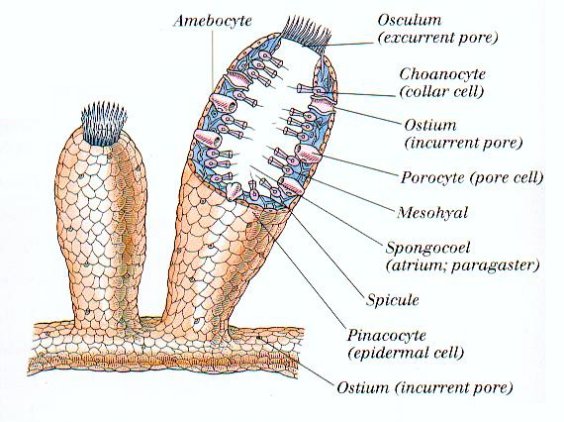

| Home Page | Overview | Site Map | Index | Appendix | Illustration | About | Contact | Update | FAQ |
 |
 |
necessary for multicellularity already. Their evolutionary steps are clearly demonstrated from single-celled aquatic protists to colonies and then appear as the collar cells in sponges. A sponge does not have anything in their bodies that can be called tissues or organs. Instead each type of sponge cell is responsible for a different activity to keep the sponge alive. Some sponges grow on rocks and are brightly colored. Sponges often are shaped like vases with a central cavity (Figure 02). Figure 03 shows the anatomy of the sponge. The internal structures are described in the followings. |
Figure 02 Sponge |
Figure 03 Sponge Anatomy [view large image] |
Although the terminologies (and hence the functions) for the various systems are in close parallel to those for the human body, the composition and distribution are vastly different. |
 |
Germ cells provide the continuity of life between generations. In higher animals (up to roundworms) there is a clear and early separation of germ cells from somatic cell types. For the other species somatic cells can readily become germ cells even in adult organisms such as the buds, and polyps of many invertebrate phyla. For those organisms where there is an established germ line that separates early in development, the germ cells come from the primordial germ cells (PGCs) in the yolk sac and then migrate into the developing gonads (the genital ridges, originally not in the lower part |
Figure 04a Primordial Germ Cells |
of the body) as shown in Figure 04a. Once in the gonad, primordial germ cells continue to divide mitotically, producing millions of potential gametes. The PGCs then undergo meiosis to produce the male and female germ cells, i.e., the sperms and eggs. |
 |
Fertilization is the process whereby two sex cells (gametes) fuse together to create a new individual with genetic potentials derived from both parents. Although the actual details of fertilization vary enormously from species to species, the events of conception generally consist of four major activities: 1. Contact and recognition between sperm and egg. In most instances, this insures that the sperm and egg are of the same species. |
Figure 04b Sperm and Egg [view large image] |
2. Regulation of sperm entry into the egg. Only one sperm can ultimately fertilize the egg. 3. Fusion of the genetic material of sperm and egg. 4. Activation of egg metabolism to start development. |
 |
microtubules. There are three fused microtubules in each group. The two centrioles are arranged such that one is perpendicular to the other. During animal cell division, the centrosome divides and the centrioles replicate. The result is two centrosomes, each with its own pair of centrioles. The two centrosomes move to opposite ends of the nucleus, and from each centrosome, microtubules grow into a "spindle" which is responsible for separating replicated chromosomes into the two daughter cells. It is found that the nucleus of the sperm cell is not necessary for the early divisions at the very beginning of development. It is the centrosome (and the centriole within) that is absolutely essential for the initial divisions. There are cases in which a centrosome can actually be created within the egg. This process is called parthenogeneseis, or virgin birth (see more below) |
Figure 04c Centrosome and Centriole [view large image] |
 |
 |
Almost all animal species reproduce sexually, which is believed to have evolved as a mean of strengthening the "fitness" of the species by mixing the genes of two different individuals from meiosis. About 1% of animal species reproduce by partenogenesis (Greek for "virgin birth"), while an even smaller fraction switch between sexual and asexual reproduction (known as cyclical parthenogenesis). |
Figure 04d Parthenogenesis Examples [view large image] |
Figure 04e Parthenogenesis |
Both kinds of parthenogenesis occur most often in low-level species including some fish, amphibians and reptiles (see some examples in Figure 04d). Some experiments try to |